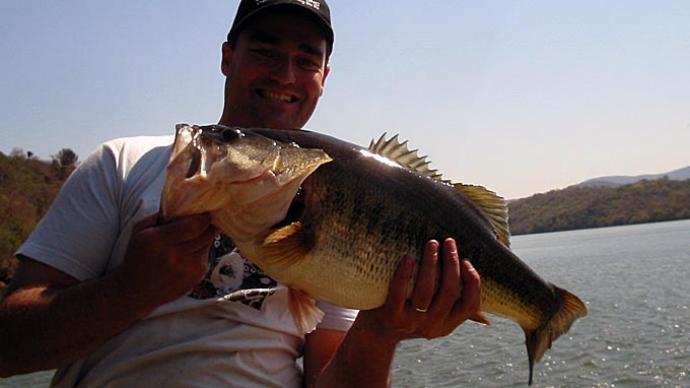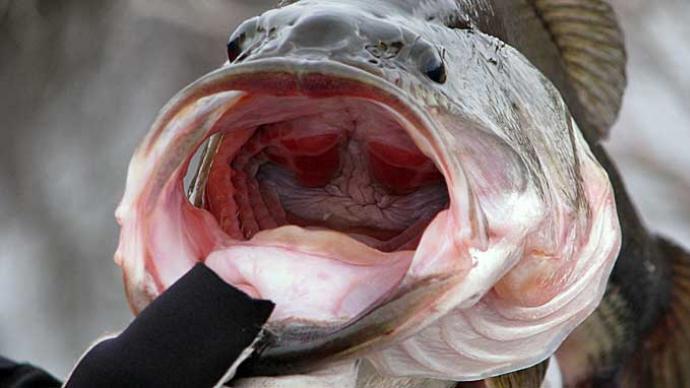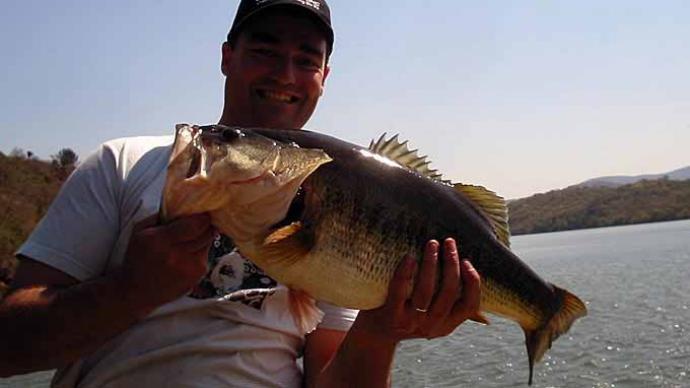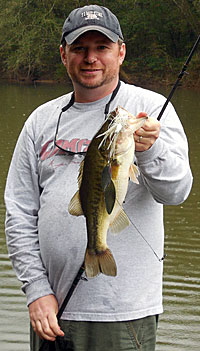
It started way back when Blue Fox rolled out the Roland Martin Big Bass Spinnerbaits. They offered two models: one with a No. 5 willow-leaf blade and the other with a No. 7. I bought both. Roland was my favorite professional angler, and I never missed his Saturday show, which followed 30 minutes of Orlando Wilson. Young and living in upstate New York, I was convinced these spinnerbaits would not catch my local bass. After all, when the Great American Fisherman went after big bass, he fished in Florida and Texas. There was no way a Northern bass would chase down something that large. No. 4 blades pushed the lure-size envelope, or so I thought. I would use my new spinnerbaits to catch Northern pike.
It turned out my father bought a few of Martin’s big-bass spinnerbaits, too. And despite my questioning his judgment again, he tied one on and fired off a cast at our favorite bass lake. I labeled the move wasted time and returned to fishing a small, time-tested lure. It wasn’t much later that I was jarred into reality by the 3-pounder he was swinging into the boat. And yes, he was smirking at me as he unhooked the spinnerbait from the bass.
Flash forward a couple of decades. I was practicing for a tournament on Lake Murray, the Saluda River impoundment near the Palmetto State’s capital, Columbia. The leaves said it was autumn, but the air temperature still felt like summer. I was sharing the boat with a friend, and we were in the river section of the lake. He dived into his tackle bag and pulled out a bag of soft plastics. No big deal, right? Wrong. In his hand was a 10-inch worm. To this day, I hear my words: “What are you going to do with that?” I recall his response was along the lines of, “Watch this.” Two pockets later, while I was busy catching nothing, he had two 3-pounders in the boat and shook off several more. After a quick stop at Walmart on the way to that evening’s tournament registration, I had my bag of giant worms.
Using large lures for bass isn’t new, but it’s not mainstream. Anglers in California, for example, regularly fish with ones that dwarf a spinnerbait sporting a No. 7 willow blade or a Texas-rigged 10-inch worm. The thing is, big lures catch bass outside the Golden State, too. They can help you catch a giant from your home waters or generate more bites, such as during the fall, when bass are keying on larger baitfish. And largemouth, smallmouth, and spotted bass like big baits equally well.
Getting bigger
The glide bait moved softly from side to side, just above a bed of submerged milfoil but far enough below the surface to be almost out of sight. It sashayed past points and pockets, edges, and thick clumps. It looked perfect, and the solid 5-pound bass agreed. Despite being seven inches long, the bass had no problem eating it.
Defining what constitutes a big bass lure can be difficult. Switching to a 6-inch worm is a big move, for example, when bass are under the throes of a cold front, and nibbling 4-inch worms slowly fished on a split-shot rig. But for the sake of this conversation, 6-inch worms aren’t big lures. We’re talking about ones that cause you to pause and question their purpose, the ones that cover your hand, and then some. That could be a ¾- or 1-ounce jig with a 6- or 7- inch swimbait threaded on the back or an 8-inch swimbait. Or it might be Strike King’s new 10X crankbait. Being big isn’t limited to one type of lure.
Spinnerbaits come in all sizes, including giant ones that force you to take breaks and rest your arm. They are the best big bait to start throwing. You might already have some ¾- or 1-ounce spinnerbait frames in your tackle box from a past ledge fishing foray. Remove the small rear blade that allowed them to go deep, and replace it with a No.7 willow-leaf blade. If you don’t have a spinnerbait that heavy, remove the rubber from a ¼- or ½-ounce rubber-core sinker and crimp the weight on the hook shank of a ½-ounce frame.
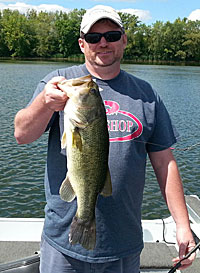
Despite the heavy heads, big blades can cause a spinnerbait to roll over. To keep one running straight, thread a 5-inch grub onto the hook. It acts like a keel, provides more action, and makes your spinnerbait look even larger. This is a great choice to slow roll over the top of submerged grass or around laydowns. And despite what you see on the Bassmaster Elite Series, spinnerbaits still catch many bass.
Glide baits are an interesting class of big-bass lures. They are slow sinkers and sometimes adorned with a curly tail grub on the back. They come alive underwater with a walk-the-dog action when you give your rod tip short, quick twitches. That motion is deadly on muskies, and many musky anglers catch big bass on them. There are big glide baits built for bass. The Deps Slide Swimmer, for example, is a 10-inch jointed glider that is gaining traction in bass fishing circles.
The magnum jigging spoon is a recent addition to the large lures for bass category. Its coming-out party was at Kentucky Lake, the final stop of the 2014 FLW Tour. Many top finishers admitted to fluttering them off the ledges. The best-known one is the Ben Parker Magnum Spoon, which is about eight inches long, weighs about 3.5 ounces, and sports a 3/0 treble hook. They dwarf salmon trolling spoons and hang with the biggest musky and Northern pike spoons. It imitates the giant gizzard shad in Southern impoundments and is a favorite treat of the biggest bass. Most traditional bass lures are closer in size to threadfin shad.
You can’t forget about giant swimbaits. They started the big lure craze. Baitsmith, 3:16, and Optimum are some of the more popular brands that continue to produce big bags at tournaments on Clear Lake and other California waters. But big swimbaits are catching elsewhere, too. Bassmaster Elite Series angler Brandon Palaniuk used an 8-inch Huddleston Deluxe to catch his personal best bass — a 12-pound, 4-ounce monster — from public water in Texas earlier this year.
Big lures are heavy. You’ll need big gear. A slightly slower action rod will load better and cast farther. Instead of a speedy 7:1 gear-ratio reel that lacks power, choose one with a lower gear ratio that acts like a winch and handles the strain of retrieving big lures. Braided line in 50- or 65-pound test is best for tying it all together.
Where to go big
The best places to use big lures are bodies of water with big bass. Those might be 15-pounders in California, Texas, or Florida; 10-pounders in the Midwest and Southeast; and 6–pounders in the North. Even though different regions have different standards for big bass, that doesn’t mean the same big lure won’t work in all those places. A 6-pound largemouth will have no problem tackling a 7-, 8- or even 10-inch bait.
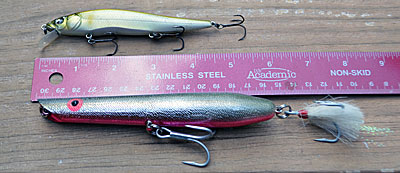
While bass will eat big lures, that doesn’t mean they are a good choice in all situations. They aren’t the best for working down a bank to catch a limit as you might with a square-bill crankbait or buzzbait. Instead, you’re better off throwing them at big-bass spots, usually isolated and not very large. It could be a rock pile in the middle of a big bay, a solitary dock at the mouth or back of a pocket, or a big log in the middle of a flat.
Sometimes, big-lure success is a result of matching the hatch. Clarks Hill Reservoir is on the Savanah River, where it splits South Carolina and Georgia. The lake’s blueback herring are almost as famous as the big bass it produces. Each year, the topwater fishing takes off in June, when these nomadic baitfish move to clay and rock points to spawn. To match their 8- to 12-inch size, anglers use large saltwater-sized poppers, such as the Cotton Cordell Pencil Popper, which perfectly match the herring’s long, slender profile.
Tidal water isn’t a place to throw big lures. Bass there have a tough life, dealing with constantly moving water. Smaller, compact lures are what they want. The same goes for most rivers.
When to throw them
Even if you are around big bass, big lures don’t work all the time. They are tools, like all lures, and produce best when conditions are prime for them. Those happen most often during two seasons – prespawn and autumn.
Big lures are effective during prespawn. By early spring, forage has had almost a full year to grow. Bass are putting on the feedbag as water temperature and their metabolism increase. Bass also haven’t had a decent meal in a while, so they are aggressive and will chase down something large.
It’s similar in autumn when forage has had the summer to develop. But instead of gearing up for the rigors of the spawn, bass are feeding up for winter. It also is a time when forage, such as shad on Southern reservoirs, collects in larger schools.
What about the rest of the year? In summer, all is good. Conditions are usually stable, and the ecosystem is at total production. Food is everywhere. Bass aren’t as motivated to chase down something big when there is so much else to eat. The only exception is early summer on ledge lakes like those along the Tennessee River system. This is when and where the giant spoons play a significant role, as do some of the larger swimbaits. The opposite is true during winter when bass kick it into neutral. They reduce their movements and intake. They are opportunistic and in no way interested in chasing something down.
A different mind-set
You’ve seen the big lures hanging at the local tackle shop, sometimes mixed with the bass gear, sometimes in the musky or striper sections, and sometimes tucked in their little corner. That’s where I found the No. 18 Rapalas, which are still in my tackle box. I bought them after bass fishing legend Larry Nixon said Lake Ontario smallmouth loved them.
You can learn to love large lures, too. Don’t dismiss them as too big to work. They are tools, like all lures, to get the most out of them. You need to understand when and where to use them. And one might produce your personal best.


